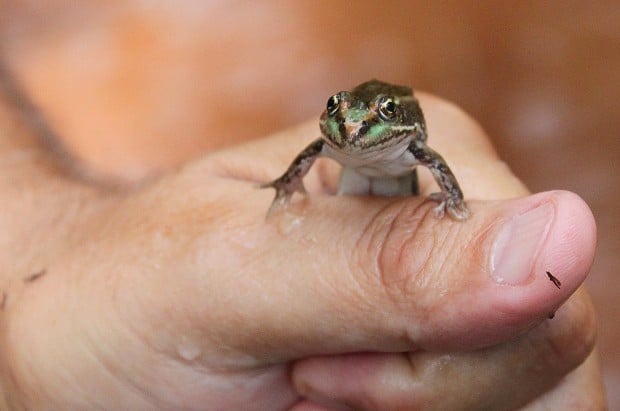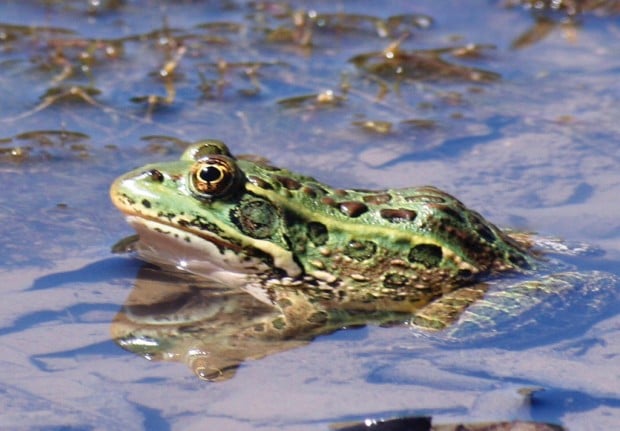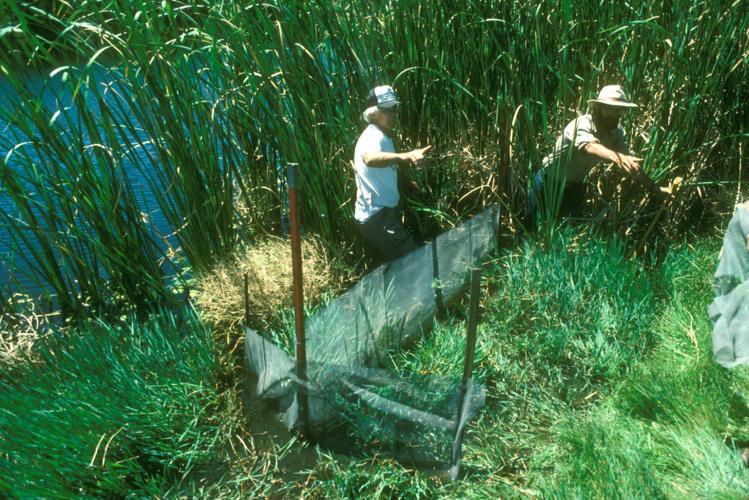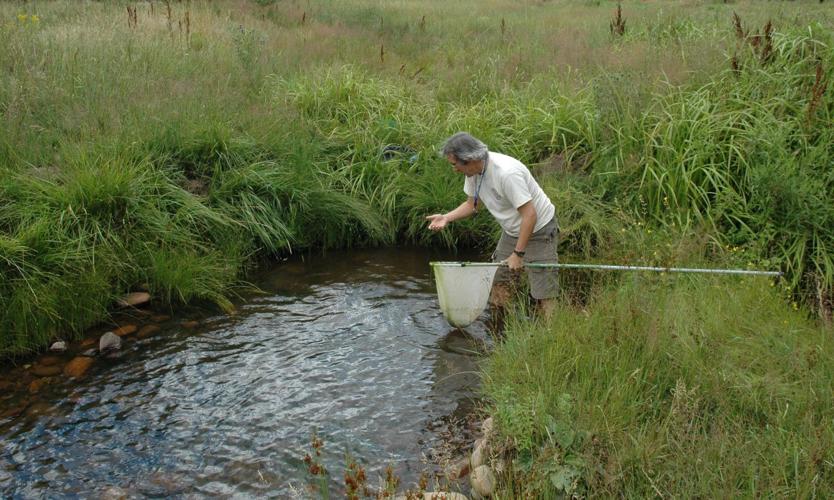The little froglets and tadpoles were going home to the Huachuca Mountains in Southeastern Arizona. Filled with seemingly endless hops and squiggles, the young Chiricahua leopard frogs were packed in large industrial containers and picnic coolers fitted with makeshift air-circulation systems and filled with water they were raised in.
The Chiricahua leopard frog is a threatened species under the U.S. Endangered Species Act. Eggs collected from the wild are raised in captivity to boast native populations.
The frogs had been reared at a variety of locations in Arizona, including the Phoenix Zoo, Arizona-Sonora Desert Museum in Tucson and Bubbling Ponds Fish Hatchery in Cornville.
Wildlife biologists, herpetologists and other trained volunteers were returning the amphibians to the riparian area where the egg masses had been collected earlier in the year – a method to manage genetics and specific native conditions. The eggs had transformed into energetic little frogs, or metamorphs.

This Chiricahua leopard frog was photographed on the east slope of the Santa Rita Mountains, within the newly designated leopard frog habitat.
Historically, the Chiricahua leopard frog lived in a variety of permanent aquatic habitats at elevations from 3,300 to 8,900 feet in central or eastern Arizona or south of the Gila River in the southeastern part of the state, as well as parts of New Mexico and Mexico. The frogs have declined due to changes in their environment, disease, and introduction of non-native species like the American bullfrog.
Loaded with precious cargo, the caravan of covered pickup trucks and vans gingerly headed out onto Interstate 10 toward a slow-moving canyon stream. After exiting the highway, the trucks maneuvered down a narrow, bumpy dirt road.
The trucks parked, and the frog-filled containers were hoisted onto external-frame backpacks for the hike into the release site. Scientists were escorting the young Chiricahua leopard frogs to one of eight areas designated for their recovery.
The last leg of the trip can be the most difficult and dangerous for the littlest tadpoles. Sloshing in the transport containers sometimes causes mortalities.
Other times, the release site is more easily accessible. The caravan or sometimes a single truck drives up to the pool, pond, lake or cattle tank, and the scientists release the frogs. At every site, the metamorphs are first acclimated to the water before being set free.
Up to 500 young frogs are needed to start a population, depending on the capacity and quality of the habitat. Fifty metamorphs may be all it takes to head-start a population of Chiricahua leopard frogs in a small spring or cattle tank. If only tadpoles are released, several hundred more will be needed to start a population, since fewer than 20 percent typically survive to reproductive age. Sometimes another cohort of frogs is brought in the following year to enhance the population if enough of the first frogs released don’t survive.
The Decline

Millions of leopard frogs once lived in Cienega Creek. "Now "I'm lucky to find maybe 20 in the whole creek,"says biologist Dennis Caldwell.
Like many amphibian species throughout the world, the Chiricahua leopard frog has declined throughout its native habitat from collections of widespread, robust populations to small, isolated populations. The fungal disease chytridiomycosis has been identified as a factor in the global loss of amphibians, including the Chiricahua leopard frog. Pesticides and other environmental contaminants, climate change, and elevated ultraviolet radiation levels may also influence the dwindling numbers of amphibians.
Chiricahua leopard frogs play an essential role in the environment as both predator and prey. A variety of native birds, fish, and snakes rely on leopard frogs as a primary food source. Many mammals, including skunks, gray foxes, raccoons, black bears, bobcats, and badgers, also feed on leopard frogs.
As predators, adult Chiricahua leopard frogs consume a variety of insects and other arthropods, thus acting as a natural pest control. In addition, “tadpoles recycle nutrients in the pond,” said Mike Sredl, the ranid frogs project coordinator for the Arizona Game and Fish Department.
The American bullfrog is one of the main culprits in the disappearance of Chiricahua leopard frogs. Like many amphibians, bullfrogs “will eat anything that they can fit into their mouth,” Sredl said.
The American bullfrog is native to the eastern United States. Government agencies and private parties introduced the bullfrog into the West in the early 1900s for sport. The Arizona Game and Fish Department released bullfrogs, Sredl said, to create a sporting opportunity for people who wanted to catch and eat frogs, mostly the legs.
The agency stopped releasing bullfrogs in 1982. “We wised up, but the damage was done,” Sredl said. No one thought the bullfrogs would decimate the native frog populations.

An American bullfrog seen on the banks of the middle San Pedro River not far from Cascabel, north of Benson.
“It is now illegal for people to release wildlife in Arizona,” Sredl said, but bullfrogs are moving across the landscape on their own. They eat Chiricahua leopard frog larvae, eggs, tadpoles, froglets, and even adults.
A group of concerned scientists and resource managers launched an aggressive initiative in the late 1990s to remove the bullfrog from the landscape in order to restore the Chiricahua leopard frog in its historical habitat. Their painstaking efforts led to the comeback of the Chiricahua leopard frog.
An Opportunistic Predator
Bullfrogs don’t only eat leopard frogs, said Cecil Schwalbe, an ecologist emeritus for the U.S. Geological Survey. From looking at the contents of their stomachs, scientists observed that bullfrogs consume every class of vertebrate found in southern Arizona. They eat mammals, birds, amphibians, fishes and reptiles, including rattlesnakes.
Schwalbe’s research shows what bullfrogs eat in the San Bernardino National Wildlife Refuge. One bullfrog had three tarantula hawks in its stomach. These huge wasps have one of the most painful stings in the Southwest.
Tarantulas are one of bullfrogs’ favorite foods. When a tarantula shows up near bullfrogs, they race to reach the tarantula first.
Bullfrogs also feast on baby coots as the young birds follow their mothers swimming in the water. Young, athletic frogs will even jump out of the water to catch a bat on the wing, Schwalbe said.
Schwalbe and his colleagues have dubbed the American bullfrog “the great white shark of the inland waterways.”
In the eastern United States, abundant predators such as raccoons and large water snakes keep bullfrogs in a natural balance with other species.
Damage Control
Biologists have used various techniques to eradicate the non-native bullfrog from riparian areas. Some of these efforts have been successful, but others have not. The bullfrog has persisted, for example, on the San Bernardino Wildlife Refuge, a large, complex set of wetlands where bullfrogs hide in the cattails and deposit thousands of eggs without detection. Bullfrogs reproduce faster than they can be removed, Sredl said. The wetlands at San Bernardino also extend across the border into Mexico, which American biologists cannot easily access.
Removing non-native species, including bullfrogs, crayfish and sport fish, from big systems like the San Pedro River and the Santa Cruz River also remains a challenge, Schwalbe said. Frog specialists and wildlife managers have made some progress in these waterways in a continuing effort to remove bullfrogs from Chiricahua leopard frog habitat.

Cecil Schwalbe, left, and Phil Rosen work on an American bullfrog removal project at San Bernardino National Wildlife Refuge in an effort to re-establishing leopard frogs there.
In many scenarios, getting rid of the bullfrog is straightforward. In small ponds or cattle tanks where the Chiricahua leopard frog or other native species has vanished, the water can be drained and all life stages of the bullfrog removed, including larvae.
When draining isn’t feasible, dip nets or seines are dragged through the pond to catch tadpoles. Seines are 10-to-50-foot-long fishing nets that are pulled through the water with poles on either end. Adult bullfrogs are shot, usually with a .22 rifle loaded with lead-free ammunition. Bullfrogs are also captured with a gig, a 10-foot long, pronged spear for hunting fish, frogs and small game.
“The removal of bullfrogs is a painstaking effort, very expensive and time consuming,” Sredl said.
The recovery program for the Chiricahua leopard frog consists of a multi-partnered cooperation of many state and federal agencies, non-governmental organizations, and volunteers, Sredl said. The exact cost of the total program, including the on-the-ground effort to remove bullfrogs, is difficult to estimate.
A Broader View
As a result of its listing under the Endangered Species Act in 2002 the Chiricahua leopard frog cannot be “taken” without a special permit, meaning it is illegal to harm, harass or pursue the frog. (Maybe someone should tell the bullfrog.)

American bullfrog eating its cousin.
Since the 2002 listing, more than 20,000 Chiricahua leopard frogs have been reintroduced to over 80 sites throughout their historical range in Arizona.
The 2007 Recovery Plan for the Chiricahua leopard frog, drafted by the U.S. Fish and Wildlife Service under the auspices of the Endangered Species Act, designates eight recovery areas in Arizona and New Mexico.
In 2012 the U.S. Fish and Wildlife Service designated more than 10,000 acres in Apache, Cochise, Gila, Graham, Pima, Santa Cruz, and Yavapai Counties in Arizona as critical habitat for the Chiricahua leopard frog. A critical habitat cannot be altered or destroyed. It is preserved for the restoration of a species that is dependent on specific geographic features for survival. The species may or may not occupy that protected habitat at the time of designation.
Into the Night
The majority of bullfrogs removed from all eight recovery areas for the Chiricahua leopard frog have been taken from Recovery Unit One, a region east of Nogales that encompasses Peña Blanca Lake and Buenos Aires National Wildlife Refuge.
“My colleague, Dennis Suhre, and I used different techniques to get the bullfrogs off Buenos Aires National Wildlife Refuge,” said Brent Sigafus, a biologist for the U.S. Geological Survey.
Like Chiricahua leopard frogs, bullfrogs need a permanent water source, Sigafus said. At Buenos Aires the only water sources are earthen cattle tanks built for livestock, not a complex system of wetlands. The refuge was a working cattle ranch from the late 1800s to 1985.
Unlike a metal drinker with a float valve, an earthen cattle tank is an open, bowl-like depression dug into the ground to collect runoff. Ranchers build dikes and berms to redirect rain into the tanks, which range from 10 feet to 200 feet wide. Livestock walk into the tank to drink. When rain is scarce, water is sometimes trucked to the tanks.
Eradicating the bullfrog from earthen tanks is usually a nighttime endeavor. Detecting the bullfrogs isn’t that difficult. “If the frogs are there, you’ll find them,” Sigafus said.
Biologists use high-powered headlamps to transfix the frogs, whose eyes give off a bright eye-shine. Working from 9 at night to 2 or 3 in the morning, Sigafus said he paddled a canoe around the earthen tanks while Suhre grabbed bullfrogs off the banks. The bullfrogs don’t expect predators to come from the water to the bank and were easily snatched. The team caught thousands of bullfrogs this way, Sigafus said.
Removal begins in May and continues into June, when it is hot and dry, and water levels are low before the summer rains. The frogs hang out at the water’s edge, where vegetation is scarce and bullfrogs stand out at this time of year.
Bullfrogs are easy to distinguish from leopard frogs. Bullfrogs have a short snout, like a bulldog. They frequently squeak when they jump into the water, while leopard frogs are silent as they leap.
After catching the bullfrogs, the scientists euthanize them with a procedure called double-pithing. A sharp probe is inserted into the spinal column at the neck toward both the head and the body. The process is said to be painless and causes instant death. The frogs are left for other animals to feed on.
Another method for killing bullfrogs is giving them an overdose of anesthetic. The frogs never wake up. Because of the injected chemical, however, frogs euthanized with this method cannot be left for scavengers.
A Race to the Finish Line

American bullfrog eating a bat.
Despite efforts beginning in the late 1990s to remove the bullfrog from Buenos Aires, the Chiricahua leopard frog blinked out from the refuge in 2001, Sigafus said. The only remaining population of Chiricahua leopard frogs in the region remained at Caponera Tank, an earthen cattle tank in the mountains just outside the refuge.
Caponera Tank once contained a healthy population of Chiricahua leopard frogs, but many years of drought had shrunk the tank and threatened the last of the frogs. In 2002, a week before the Chiricahua leopard frog was listed as threatened, Sigafus and Suhre (the field crew for Schwalbe and collaborator Phil Rosen, a University of Arizona researcher) made a last-ditch attempt to save the remaining population. Seven adult frogs and 13 tadpoles were caught and moved to a privately owned pond.
The scientists received emergency verbal authority from the Arizona Game and Fish Department to rescue these frogs under their scientific collecting permit, which authorized them to study the leopard frogs, Schwalbe said. After the frog became federally listed, the scientists would have needed a federal permit to legally go back for more. Although both Arizona Game and Fish and U.S. Fish and Wildlife biologists searched the area repeatedly, Chiricahua leopard frogs have not been seen again at Caponera Tank.
Time was critical as the water in the tank disappeared. The rescued frogs proliferated in the private pond. Hundreds of tadpoles hatched six weeks later, and in 2003 tiny frogs and tadpoles were taken to Buenos Aires National Wildlife Refuge and released in earthen cattle tanks free of bullfrogs. Those frogs were the source of the thousands of Chiricahua leopard frogs that now live in the Altar Valley, where Buenos Aires and Recovery Unit One are located.
By 2004 all the bullfrog breeding sites had been eliminated on the main portion of Buenos Aires National Wildlife Refuge.
An especially wet summer in 2007, however, with more than double the average rainfall, allowed bullfrogs to disperse long distances. They returned to the refuge and invaded some of the new leopard frog populations.
Once again, the scientists rallied in defense of the Chiricahua leopard frog. With the help of frog biologists from Arizona Game and Fish Department and the U.S. Fish and Wildlife Service, the scientists removed the new invaders from the refuge. The bullfrog hasn’t been seen in the southern portion of Buenos Aires since 2010.
In 2008 Schwalbe and Sigafus began monitoring the Chiricahua leopard frog at three cattle tanks on Buenos Aires National Wildlife Refuge. The scientists observe how the leopard frog disperses and uses the environment.
One site in the study dried up, but those frogs found a new cattle tank.
In 2013, the Chiricahua leopard frogs in the study migrated to an earthen cattle tank at a site off the refuge. These frogs are a healthy, breeding population, Sigafus said, “and don’t seem to mind the cattle that come to drink.”
Local Concerns
Many people enjoy having bullfrogs on their property because they don’t realize that this non-native species diminishes native biodiversity, Sredl said. Even when landowners understand the problem, they are sometimes hesitant about removing bullfrogs from ponds, tanks or other water sources on their land.

Michael Sredl of Arizona Game and Fish surveys for leopard frogs Aug. 2, 2005 on the Mogollon Rim south of Heber in Black Canyon.
Ranchers who object to bullfrog removal usually want to be left alone. Some ranchers, for example, are suspicious of government agencies and the issues related to endangered species, Sredl said.
Other ranchers, like Sarah Barchas, embrace the opportunity to help preserve a threatened or endangered species. Barchas owned and ran the Brown Canyon Ranch near Sierra Vista, Arizona, for 40 years.
Chiricahua leopard frogs were discovered in a natural pond on the cattle ranch in the 1970s. The pond, replenished from an underground well and the Brown Canyon Spring, was also a source of water for the cattle that Barchas kept on the property. When Barchas learned that the pond contained a declining population of frogs, she wanted to protect the frogs and fenced off one side from her cattle.
In 2010 Chiricahua leopard frogs were also found on grazing allotments associated with High Haven Ranch, a few miles north of Sonoita. Barchas acquired the ranch as part of a land swap when the Forest Service acquired the Barchas Ranch and renamed it Brown Canyon Ranch.
Chiricahua leopard frogs were living in a galvanized metal cattle drinker under a mesquite tree in one of the livestock corrals. The frogs were taking advantage of exit and entrance ramps Barchas had installed for small animals to climb in and out of the drinker. When the frogs were discovered, Barchas added ramps to other drinkers in the corral, installed additional drinkers, and added entrance and exit ramps to more than 15 drinkers in other corrals. The cowboy who wrangled her cattle was also recruited to tend the frogs.
“They were an important part of nature, and I enjoyed seeing them,” Barchas said. “All through the years I felt it is very, very important for ranchers to live in harmony with nature and the wildlife.”
Barchas retired in 2014. The U.S. Forest Service now owns Brown Canyon Ranch, but Barchus remains involved with the ranch even in retirement. The Chiricahua leopard frogs are thriving at both sites despite the change of owners and the continued threat of disease and non-native species.
Recently, someone put southern leopard frogs into the pond at Brown Canyon Ranch. The Chiricahua leopard frogs may have to be moved until the southern leopard frogs are captured, Sredl said. The two species could compete or crossbreed.
Tomorrow
Removal of the bullfrog is critical to the comeback of the Chiricahua leopard frog, but its recovery also requires other steps, from habitat improvement to restoring and improving wetlands.
A new project incorporates radio telemetry to observe the frogs. “We are going to put little radios on them and watch them hop around,” Sigafus said.
A tiny belt goes around the frog, and a radio and antennae hang off the belt. The entire apparatus weighs about a gram, which is about the weight of a small paper clip.
The study will examine how the frogs are using the environment, what factors affect their health, and what resources they need to thrive.











